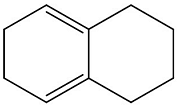Calculate the \( \lambda_{\text{max}} \) of the following molecule:
Show Hint
- 283 nm
- 273 nm
- 234 nm
- 244 nm
The Correct Option is B
Solution and Explanation
The \( \lambda_{\text{max}} \), or the maximum absorption wavelength, is an important characteristic of a molecule and is typically determined by its conjugated system, i.e., the extent of \(\pi-electron \) delocalization. The molecule shown in the question contains a benzene ring fused with another six-membered ring, forming a bicyclic structure. In general, the \(\lambda _\text{max}\) of such molecules can be predicted based on their conjugation. The molecule in question has an extended conjugated system, and based on similar structures and their known absorption maxima, we expect the \(\lambda _\text{max}\) for this molecule to be around 273 nm. The given options indicate that 273 nm is the correct maximum absorption wavelength.
Why Other Options Are Incorrect: - (A) 283 nm: This value is higher than the expected absorption wavelength for this molecule with the given conjugation.
- (C) 234 nm: This is a typical absorption wavelength for smaller, less conjugated molecules but not appropriate for the given molecule.
- (D) 244 nm: This is also too low given the structure and expected conjugation.
Thus, the correct value for \( \lambda_{\text{max}} \) is 273 nm, corresponding to option (B).
Top Questions on Nucleic acid: replication, transcription, splicing, translation
- Calculate the λmax of the following molecule:

- GPAT - 2024
- Biochemistry
- Nucleic acid: replication, transcription, splicing, translation
- In a lactic acid solution at pH 4.8, the concentrations of lactic acid and lactate are 0.01 M and 0.087 M, respectively. The calculated pKa of lactic acid is _______. (Round off to one decimal place)
- GATE XL - 2024
- Biochemistry
- Nucleic acid: replication, transcription, splicing, translation
- DNA and RNA contain the following two major purine bases:
- GPAT - 2023
- Biochemistry
- Nucleic acid: replication, transcription, splicing, translation
- Given below are two statements
Statement I: Sequencing of DNA is much easier than RNA sequencing due to greater stability
Statement II: The chemical method of DNA sequencing (Maxam & Gilbert) works for only single stranded DNA
In light of the above statements, choose the correct answer from the options given below- GPAT - 2022
- Biochemistry
- Nucleic acid: replication, transcription, splicing, translation
- For protein detection most commonly used probe is:
- GPAT - 2019
- Biochemistry
- Nucleic acid: replication, transcription, splicing, translation
Questions Asked in GPAT exam
- Blood concentration ratio of the combination of trimethoprim and sulfamethoxazole after being given in a 1:5 ratio is
- GPAT - 2025
- antimicrobials
- Which of the following alkaloids are found as salts of meconic acid?
- GPAT - 2025
- Introductory Pharmacognosy
Choose the correct match of laxative and its Mechanism of Action (MOA):

- GPAT - 2025
- Laxative
Match the following:
(P) Schedule H
(Q) Schedule G
(R) Schedule P
(S) Schedule F2
Descriptions:
(I) Life period of drugs
(II) Drugs used under RMP
(III) List of Prescription Drugs
(IV) Standards for surgical dressing
- GPAT - 2025
- Drug therapy
- Which anemia is caused due to Microcytic, hypochromic red blood cells?
- GPAT - 2025
- Organic Chemistry